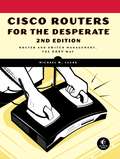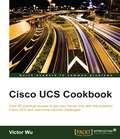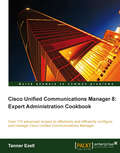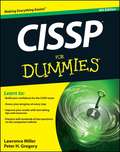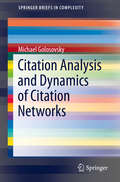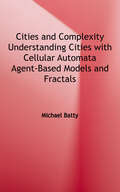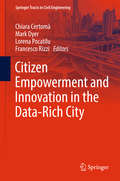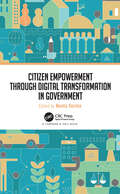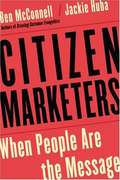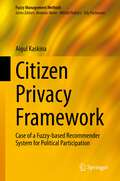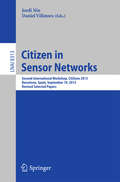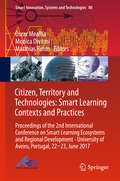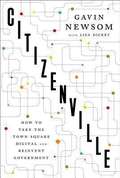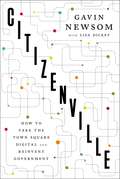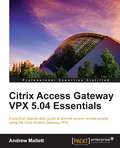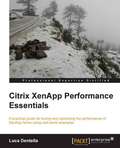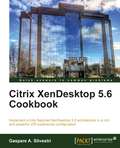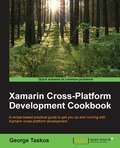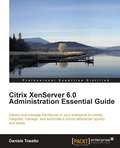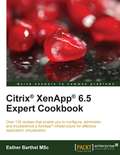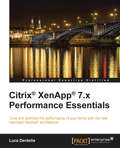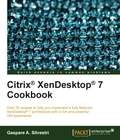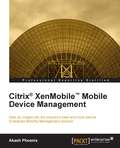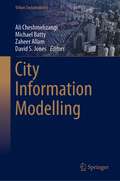- Table View
- List View
Cisco Routers for the Desperate, 2nd Edition: Router Management, the Easy Way
by Michael W. LucasCisco routers and switches are the cornerstones of many networks. But when things break, repairs can intimidate even the most competent administrator. Luckily, just knowing the "in case of emergency" basics will take you far.Just like the original, this second edition of the highly acclaimed Cisco Routers for the Desperate is written for the administrator in crisis mode. Updated to cover switches and the latest Cisco terminology, with a tighter focus on the needs of the small network administrator, this second edition gives you what you need to know to provide reliable network services and fix problems fast. You'll find coverage of:–Installation—how to get your router and network connections up and running right the first time–Troubleshooting routers and switches, so that you can determine whether your hardware or the Internet is broken–Security concerns, like how to keep your network equipment safe from hackers and install a private network between two offices–How to implement basic network redundancy to reduce the risk of network downtimeCisco Routers for the Desperate, 2nd Edition is designed to be read once and left alone until something breaks. When it does, you'll have everything you need to know in one easy-to-follow guidebook.
Cisco UCS Cookbook
by Victor WuOver 40 practical recipes to get your hands dirty with the powerful Cisco UCS and overcome various challenges About This Book * Master the skills of minimizing cost, enabling your business to work faster by reducing cycle times for reporting and improving overall revenue * Work through hands-on recipes for efficient deployment approaches, see computing techniques, and explore new operational models with UCS * Render a better work-flow management, ensure effective monitoring, and learn new deployment paradigms for the operational infrastructure with the help of this book Who This Book Is For This book is for competent system/network or storage administrators who are working with Cisco UCS, but now want to learn new ways to compute UCS. What You Will Learn * Familiarize yourself with information on the latest information on memory management practices, virtualization architectures, and the specific technical advantages of UCS * Get a concrete understanding of integrating processes and techniques to ensure effective convergence of LAN/SAN * Get to know the best practices of Cisco UCS, EMC Storage, and VMware vSphere * Master migrating data from other band servers or Blade to Cisco UCS * Comprehend how to replicate and back up UCS to remote sites UCS * Assimilate innovative techniques to deploy UCS to leverage its full potential * Gather information on installing and configuring automatic and manual Pinning * Discover ways to integrate a system in Cisco UCS In Detail Cisco Unified Computing System (UCS) is a data center server platform that is used for computing, deploying, and storing resources in data center environments. This cookbook aims to teach you about various tasks you can implement to improve your existing method of configuring and deploying UCS. You will start by learning how to upgrade your firmware on Brocade and Cisco Fibre Channel Switch and will move on to enhance your knowledge of LAN connectivity. We will then discuss how to configure Windows 2008 and 2012 local boot in Cisco UCS. Next, you will learn how to install the operating system on Cisco UCS and use Cisco UCS Power Calculator to calculate the UCS consumption. Finally, we'll take a look at backup solutions. By the end of the book, you will know several ways to build and compute in data center environment using Cisco UCS. Style and approach This guide explains every task in a conversational and easy-to-follow style. You can open this book up to the task you want to learn and will be able to perform that task by the end of the recipe.
Cisco Unified Communications Manager 8: Expert Administration Cookbook
by Tanner EzellThis book is written in an easy-to-read style, with a strong emphasis on real-world, practical examples. Step-by-step explanations are provided for performing important administration tasks. If you are Cisco Unified Communications administrators or engineers looking forward for advanced recipes to perform important administration tasks, then this is the best guide for you. This book assumes familiarity with the basics of Cisco's Unified Communications Manager architecture.
Cissp For Dummies
by Miller Lawrence C. Miller Peter GregoryA fully updated guide to CISSP certification CISSP certification is the most prestigious and highly valued of the security certifications. This is the book you need to approach the exam with confidence and become CISSP certified! The CISSP Body of Knowledge underwent many changes in 2012, and this book covers them all. With a down-to-earth approach, it provides all the information covered in the exam plus numerous self-assessment tools, Quick Assessment and Prep tests to give you practice, a sample exam, and hundreds of randomly generated review questions on the Dummies Test Engine, available on the companion website. The coveted CISSP certification is the most prestigious of the security certifications; this popular guide covers all the latest updates to prepare you for the exam Includes various self-assessment tools to help you gauge your progress, including Quick Assessment tests at the beginning of every chapter, a Prep Test at the end of every chapter, a sample exam, and hundreds of randomly generated test questions Features the popular Dummies Test Engine on the companion website Offers test-taking tips and plenty of resources for further study CISSP For Dummies, 4th Edition gives you the tools to take the CISSP exam with confidence and earn your certification!
Citation Analysis and Dynamics of Citation Networks (SpringerBriefs in Complexity)
by Michael GolosovskyThis book deals with the science of science by applying network science methods to citation networks and uniquely presents a physics-inspired model of citation dynamics. This stochastic model of citation dynamics is based on a well-known copying or recursive search mechanism. The measurements covered in this text yield parameters of the model and reveal that citation dynamics of scientific papers is not linear, as was previously assumed. This nonlinearity has far-reaching consequences including non-stationary citation distributions, diverging citation trajectories of similar papers, and runaways or "immortal papers" with an infinite citation lifespan. The author shows us that nonlinear stochastic models of citation dynamics can be the basis for a quantitative probabilistic prediction of citation dynamics of individual papers and of the overall journal impact factor. This book appeals to students and researchers from differing subject areas working in network science and bibliometrics.
Cities and Complexity: Understanding Cities with Cellular Automata, Agent-Based Models, and Fractals
by Michael BattyThis is a crucial text for anyone interested in the interrelationships of media and design processes. As urban planning moves from a centralized, top-down approach to a decentralized, bottom-up perspective, our conception of urban systems is changing. In Cities and Complexity, Michael Batty offers a comprehensive view of urban dynamics in the context of complexity theory, presenting models that demonstrate how complexity theory can embrace a myriad of processes and elements that combine into organic wholes. He argues that bottom-up processes--in which the outcomes are always uncertain--can combine with new forms of geometry associated with fractal patterns and chaotic dynamics to provide theories that are applicable to highly complex systems such as cities. Batty begins with models based on cellular automata (CA), simulating urban dynamics through the local actions of automata. He then introduces agent-based models (ABM), in which agents are mobile and move between locations. These models relate to many scales, from the scale of the street to patterns and structure at the scale of the urban region. Finally, Batty develops applications of all these models to specific urban situations, discussing concepts of criticality, threshold, surprise, novelty, and phase transition in the context of spatial developments. Every theory and model presented in the book is developed through examples that range from the simplified and hypothetical to the actual. Deploying extensive visual, mathematical, and textual material, Cities and Complexity will be read both by urban researchers and by complexity theorists with an interest in new kinds of computational models.
Citizen Empowerment and Innovation in the Data-Rich City (Springer Tracts in Civil Engineering)
by Chiara Certomà Mark Dyer Lorena Pocatilu Francesco RizziThis book analyzes the ongoing transformation in the "smart city" paradigm and explores the possibilities that technological innovations offer for the effective involvement of ordinary citizens in collective knowledge production and decision-making processes within the context of urban planning and management. To so, it pursues an interdisciplinary approach, with contributions from a range of experts including city managers, public policy makers, Information and Communication Technology (ICT) specialists, and researchers. The first two parts of the book focus on the generation and use of data by citizens, with or without institutional support, and the professional management of data in city governance, highlighting the social connectivity and livability aspects essential to vibrant and healthy urban environments. In turn, the third part presents inspiring case studies that illustrate how data-driven solutions can empower people and improve urban environments, including enhanced sustainability. The book will appeal to all those who are interested in the required transformation in the planning, management, and operations of data-rich cities and the ways in which such cities can employ the latest technologies to use data efficiently, promoting data access, data sharing, and interoperability.
Citizen Empowerment through Digital Transformation in Government
by Neeta VermaTechnological innovations across the globe are bringing profound change to our society. Governments around the world are experiencing and embracing this technology-led shift. New platforms, emerging technologies, customizable products, and changing citizen demand and outlook towards government services are reshaping the whole journey. When it comes to the application of Information and Communication Technologies (ICT) in any sector, the Government of India has emerged as an early adopter of these technologies and has also focused on last-mile delivery of citizen-centric services. Citizen Empowerment through Digital Transformation in Government takes us through the four-decade long transformational journey of various key sectors in India where ICT has played a major role in reimagining government services to citizens across the country. It touches upon the emergence of the National Informatics Centre as a premier technology institution of the Government of India and its collaborative efforts with the Central, State Governments, as well as the District level administration, to deliver best-in-class solutions. Inspiring and informative, the book is filled with real-life transformation stories that have helped to lead the people and the Government of India to realize their vision of a digitally empowered nation.
Citizen Marketers: When People Are the Message
by Ben Mcconnell Jackie HubaCitizen marketers: Who are they? What motivates them? Marketing experts Ben McConnell and Jackie Huba explore the ramifications of social media in Citizen Marketers. As everyday people increasingly create content on behalf of companies, brands or products, they are collaborating with others just like themselves and forming ever-growing communities of enthusiasts and evangelists. From the rough to the sophisticated, the ""user-generated media"" of blogs, online bulletin boards, podcasts, photos, songs, and animations are influencing companies' customer relationships, product design, and marketing campaigns, whether they participate willingly or not.
Citizen Privacy Framework: Case of a Fuzzy-based Recommender System for Political Participation (Fuzzy Management Methods)
by Aigul KaskinaThis book presents the concept of a fuzzy-based recommender system for user account privacy settings that can be used for citizen participation on online political platforms. The elaborated components are exemplarily based on the needs of a political platform implemented during the presidential election in Ecuador. The book readdresses the issue of privacy paradox demonstrating that, indeed, users’ actual decisions of being private in most cases diverge with their initial privacy intentions. The two concepts presented in the book - the citizen privacy profile framework and the prototype fuzzy-based privacy settings recommender system - can be adapted by different organizations such as government institutions, NGOs, or private online service providers to meet their specific needs. The book will be of interest to researchers and practitioners in the areas of usage modeling, privacy, system design, and for service providers in eDemocracy.
Citizen in Sensor Networks: Second International Workshop, CitiSens 2013, Barcelona, Spain, September 19, 2013, Revised Selected Papers (Lecture Notes in Computer Science #8313)
by Jordi Nin Daniel VillatoroThis book constitutes the proceedings of the Second International Conference on Citizen Sensor Networks, CitiSens 2013, held in Barcelona, Spain, in September 2013. The 8 papers presented in this volume were carefully reviewed and selected from 16 submissions. The topics covered are: trajectory mining, smart cities, multi-agents systems, networks simulation, smart sensors and clustering or data anonymization.
Citizen, Territory and Technologies: Proceedings of the 2nd International Conference on Smart Learning Ecosystems and Regional Development - University of Aveiro, Portugal, 22-23, June 2017 (Smart Innovation, Systems and Technologies #80)
by Óscar Mealha Monica Divitini Matthias RehmThis book gathers a selection of the articles accepted for presentation and discussion at the 2nd International Conference on Smart Learning Ecosystems and Regional Developments (SLERD 2017), held 22-23 June What characterizes smart learning ecosystems? What is their role in city and regional development and innovation? How can we promote the engagement of citizens in smart learning ecosystems? These are some of the questions addressed at SLERD 2017 and documented here. The proceedings include scientific papers that endeavor to understand, devise and promote innovative human-centric design and development methods, education/training practices, informal social learning, and citizen-driven policies. The individual papers elaborate on the notion of smart learning ecosystems, study the relation of smart learning ecosystems with As such, they help to foster the social innovation sectors, Information and Communication Technology (ICT) and economic development and deployment strategies, alongside new policies for smarter, proactive citizens - making them a valuable resource for researchers and policymakers alike.
Citizenville
by Gavin Newsom"Citizenville offers both an impassioned plea for more tech-enabled government and a tour d'horizon of the ways some governments have begun using technology to good effect... a fast-paced and engaging read” --San Francisco Chronicle A rallying cry for revolutionizing democracy in the digital age, Citizenville reveals how ordinary Americans can reshape their government for the better. Gavin Newsom, the lieutenant governor of California, argues that today’s government is stuck in the last century while-in both the private sector and our personal lives-absolutely everything else has changed. The explosion of social media, the evolution of Internet commerce, the ubiquity of smart phones that can access all the world’s information; in the face of these extraordinary advances, our government appears increasingly irrelevant and out of touch. Drawing on wide-ranging interviews with thinkers and politicians, Newsom’s Citizenville shows how Americans can transform their government, taking matters into their own hands to dissolve political gridlock even as they produce tangible changes in the real world. When local Web designers wanted to prevent muggings in Chicago and Oakland, they created innovative crime-mapping tools using public police data. When congressional representatives wanted citizens’ input on new legislation, they used interactive blogging tools to invite public comments and changes. When a town in Texas needed to drum up civic engagement, officials invented a local digital "currency” to reward citizens for participating in government-making small-town politics suddenly as fun and addictive as online games such as Farmville. Surveying the countless small advances made by ordinary Americans in reinventing government for the twenty-first century, Newsom unveils a path for American prosperity and democratic vitality. Newsom explains how twenty-first-century problems are too big and too expensive for the government simply to buy solutions; instead, Americans must innovate their way out. Just as the post office and the highway system provide public infrastructure to channel both personal and private enterprise-a platform upon which citizens can grow-so too could a modern digital government house the needs, concerns, information, and collaboration of an enlightened digital citizenry. A vision for better government that truly achieves the ancient goal of commonwealth and a triumphant call for individuals to reinvigorate the country with their own two hands, Citizenville is a timely road map for restoring American prosperity and for reinventing citizenship in today’s networked age. .
Citizenville: How to Take the Town Square Digital and Reinvent Government
by Lisa Dickey Gavin Newsom"Citizenville offers both an impassioned plea for more tech-enabled government and a tour d'horizon of the ways some governments have begun using technology to good effect. . . a fast-paced and engaging read" --San Francisco Chronicle A rallying cry for revolutionizing democracy in the digital age, Citizenville reveals how ordinary Americans can reshape their government for the better. Gavin Newsom, the lieutenant governor of California, argues that today's government is stuck in the last century while--in both the private sector and our personal lives--absolutely everything else has changed. The explosion of social media, the evolution of Internet commerce, the ubiquity of smart phones that can access all the world's information; in the face of these extraordinary advances, our government appears increasingly irrelevant and out of touch. Drawing on wide-ranging interviews with thinkers and politicians, Newsom's Citizenville shows how Americans can transform their government, taking matters into their own hands to dissolve political gridlock even as they produce tangible changes in the real world. When local Web designers wanted to prevent muggings in Chicago and Oakland, they created innovative crime-mapping tools using public police data. When congressional representatives wanted citizens' input on new legislation, they used interactive blogging tools to invite public comments and changes. When a town in Texas needed to drum up civic engagement, officials invented a local digital "currency" to reward citizens for participating in government--making small-town politics suddenly as fun and addictive as online games such as Farmville. Surveying the countless small advances made by ordinary Americans in reinventing government for the twenty-first century, Newsom unveils a path for American prosperity and democratic vitality. Newsom explains how twenty-first-century problems are too big and too expensive for the government simply to buy solutions; instead, Americans must innovate their way out. Just as the post office and the highway system provide public infrastructure to channel both personal and private enterprise--a platform upon which citizens can grow--so too could a modern digital government house the needs, concerns, information, and collaboration of an enlightened digital citizenry. A vision for better government that truly achieves the ancient goal of commonwealth and a triumphant call for individuals to reinvigorate the country with their own two hands, Citizenville is a timely road map for restoring American prosperity and for reinventing citizenship in today's networked age.
Citrix Access Gateway VPX 5.04 Essentials
by Andrew MallettThis book is written in an easy-to-read style, with a strong emphasis on real-world, practical examples. Step-by-step explanations are provided for performing important tasks. If you an administrator or IT professional looking for basic knowledge of Citrix products such as XenApp (or its predecessor: Presentation Server), or XenDesktop and remote access solution, then this is the best guide for you. This will help you with the basic premise of why we need to implement the ICA Proxy for remote access. You may then note the benefits of full VPN access, but no prior experience with Virtual Private Networks is required as we step you through this, although basic networking and routing experience would not go awry here.
Citrix XenApp Performance Essentials
by Luca DentellaA practical hands-on tutorial including multiple examples on application management using Citrix XenApp 6.5.Citrix XenApp Performance Essentials is intended for IT architects and system administrators who work with Citrix XenApp and who need an agile, practical guide to tune and optimize the performance.
Citrix XenApp® 7.5 Desktop Virtualization Solutions
by Andy PaulIf you are a Citrix® engineer, a virtualization consultant, or an IT project manager with prior experience of using Citrix XenApp® and related technologies for desktop virtualization and want to further explore the power of XenApp® for flawless desktop virtualization, then this book is for you.
Citrix XenDesktop 5.6 Cookbook
by Gaspare A. SilvestriThis Cookbook style offers techniques and skills through recipes, with step-by-step instructions for developers who want to use XenDesktop 5.6 to maximize their control and performance. A Packt Cookbook is written so it can be read and worked through chapter by chapter or you can dive in and out, doing the recipes in the order that suits you best. This book is for experienced IT professionals who want to have a more fluid and accessible control over their resources and who want a centralized container of procedures and advanced tasks to manage it. It is also suitable for IT technicians who want to integrate a more theoretical approach with a step-by-step installation for the first time.
Citrix XenDesktop® Cookbook - Third Edition
by Gaspare A. SilvestriOver 40 engaging recipes that will help you implement a full-featured XenDesktop® 7.6 architecture and its main satellite components About This Book * Implement, configure, and optimize the migration from a physical to a VDI architecture using XenDesktop 7.6 * Publish desktops and applications to the end user devices, optimizing their performance and increasing the security for the delivered resources * A pragmatic guide that helps you to explore the XenDesktop 7.6 architecture and its related components to implement a service-oriented architecture based on the Citrix FlexCast approach Who This Book Is For If you are a system administrator or an experienced IT professional who wants to refer to a centralized container of procedures and advanced tasks in XenDesktop, this is the book for you. Experience of the virtualized environment and an understanding of the general concepts of desktop virtualization (VDI) are required. What You Will Learn * Upgrade from XenDesktop 5.6 / 7.x to XenDesktop 7.6 * Configure and deploy virtual machines for XenDesktop 7.6 * Perform configuration and optimization operations for desktop and server OS images for future deployments * Plan and configure XenDesktop user experience * Execute desktop environment administration tasks, including catalog creation, power management, and resource allocation * Understand how to publish the hosted applications, Local Access Apps (LAA), and applications using Microsoft App-V * Work with XenDesktop PowerShell to reduce the time required to perform the management tasks by the creation of the PowerShell scripts * Implement the two-factor hardware and software authentication for XenDesktop * Install and configure Citrix Netscaler Gateway 10.5 and Citrix XenMobile 10 to improve the quality, the performance, and the manageability of your Virtual Desktop Infrastructure (VDI) architecture In Detail In the era of Bring Your Own Device (BYOD) and consecration of the mobile devices, Citrix has strengthened its position in this market, powering its desktop and application virtualization platforms, integrating the ability to publish virtual and physical desktops with the capability to assign applications and contents in a secure manner on any device, anywhere, more than previous versions. The XenDesktop 7.6 version is a more integrated platform, which permits the use and interaction with mobility and cloud platforms leaders in the market. This book will help you understand how to implement, configure, and optimize migration from a physical to a VDI architecture, moving from a standard application approach to a centralized and more secure way to assign and release resources to the end users. The book begins with the upgrade and installation procedures for the core infrastructural components, along with an explanation of how to deploy and optimize procedures for desktop virtual machines. Moving on, you will perform desktop and applications deployment through the XenDesktop core plus integrated publishing platforms, such as Microsoft App-V. Finally, the book explains how to install and configure important collateral platforms such as the Citrix Netscaler, Citrix CloudBridge and Citrix XenMobile platforms, along with execution of the most advanced activities and configurations. Style and approach This book is a step-by-step course that includes standard and high-level tasks oriented to deploy a full-functioning Citrix environment. This practical approach is based on both GUI and command-line operations, which gives IT professionals an alternative on the way to operate, where possible.
Citrix XenServer 6.0 Administration Essential Guide
by Daniele TosattoThis is a practical, concise step-by-step tutorial with screenshots for carrying out tasks showing you how to manage and administer a XenServer in your business. The author brings his own extensive knowledge of XenServer. The book is full of best practices and tips that will help you benefit from the author's experience in working with XenServer. If you are an administrator working on XenServer, this book is for you. The book assumes that you have a basic understanding of XenServer administration, but need not have working experience with XenServer. You must be well aware of virtualization concepts as the book does not cover that. IT consultants, service providers and architects, who want to approach XenServer as a virtualization platform will also find this book useful.
Citrix® XenApp® 6.5 Expert Cookbook
by Esther Barthel MscThis is an expert level guide that enables you to employ the Citrix XenApp tool to host an effective and secured application virtualization interface. Recipes containing numerous tips and examples are well organized, and cover the advanced concepts of building a robust virtualization infrastructure. If you are a Citrix XenApp expert and wish to enhance your skills by learning theadvanced features and configurations of a XenApp, then this book is for you. This is a follow up to the Getting Started with Citrix XenApp 6.5 Packt Publishing book. Server administrators willing to explore management and monitoring tools who wish to automate Citrix XenApp configurations with PowerShell scripting will certainly be at ease with this book.
Citrix® XenApp® 7.x Performance Essentials
by Luca DentellaThis book is a practical, example-oriented guide that provides you with guidelines, best practices, and real-world examples that will help you to improve the performance of your infrastructure, identify and solve possible bottlenecks, and use advanced features. The advantages of cost reduction, reduced deployment time, inclusion of AppDNA™ with XenApp®, streamlining IT operations, and EdgeSight® user experience monitoring have all been covered to enable you to make use of the latest version fully. The book begins with an in-depth examination of the new FlexCast® Management Architecture, followed by optimization techniques using Director and EdgeSight®. You will also learn how to optimize end user experience and publish applications through WAN links.
Citrix® XenDesktop® 7 Cookbook
by Gaspare A. SilvestriA step-by-step course that includes tasks ranging from a standard to high-level difficulty, oriented to deploy an enterprise production VDI environment. This practical approach is based on both GUI and command line operations, which gives you as an IT professional the alternatives to operate the system wherever possible. If you are a system administrator or an experienced IT professional who wants to refer to a centralized container of procedures and advanced tasks in XenDesktop, this is the book for you. If you are an IT technician approaching this technology for the first time, who wants to integrate a more theoretical formative process with step-by-step installation and configuration activities, this book will also help you. You will need to have experience of the virtualized environment and an understanding of the general concepts of desktop virtualization (VDI).
Citrix® XenMobile™ Mobile Device Management
by Akash PhoenixA step-by-step tutorial covering the specifics of mobile development management with a flurry of relevant screenshots for better understanding and practical learning. This book is for professionals who want to familiarize themselves with mobile device management and who aspire to discover how MDM software is designed to meet the most complex and demanding mobile requirements when it comes to securing their mobile enterprise.
City Information Modelling (Urban Sustainability)
by Michael Batty Ali Cheshmehzangi David S. Jones Zaheer AllamThis is the first book focused on City Information Modelling (CIM) that puts together a collection of recent studies related to concepts and trends in CIM, application and digitization processes/methods, and frameworks and practices of CIM. This emerging topic is important to various research and practice under sectors of the built environment, civil engineering, urban planning, urban design, and urban management. CIM aligns well with smart cities, data-driven urban analytics and optimization, information-based city planning, and future development paradigms. City Information Modelling provides global case study examples in three parts. At first, the contributors offer several examples of ‘Concepts and Trends’, where CIM is explored further in urban management, urban sustainability, and big data studies. In the second part, the book offers various examples of application and digitization processes or methods related to urban planning and design practices. In the third part, the contributors delve into several examples of CIM frameworks and practices critical to contemporary research, planning and design paradigms, and future practices. This collection is a niche resource for various stakeholders, particularly urban scientists, urban analytics, urban practitioners, and researchers. It will also be a valuable collection for those who work with information-based models, urban optimization models, and big data analytics, particularly from policy and practice perspectives. The findings of this collection help direct future research in CIM and suggest opportunities for big-data urban research, integrated urban models, and holistic frameworks in sustainable cities, smart cities, and future cities.
